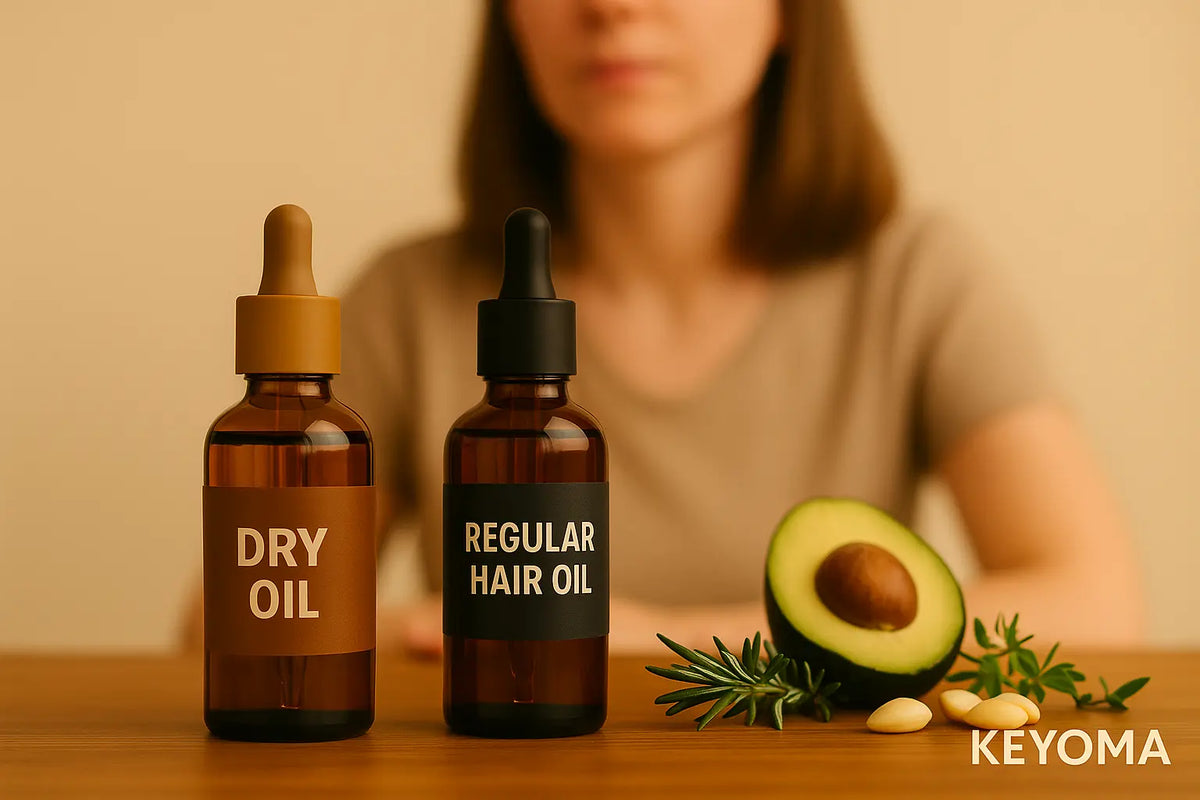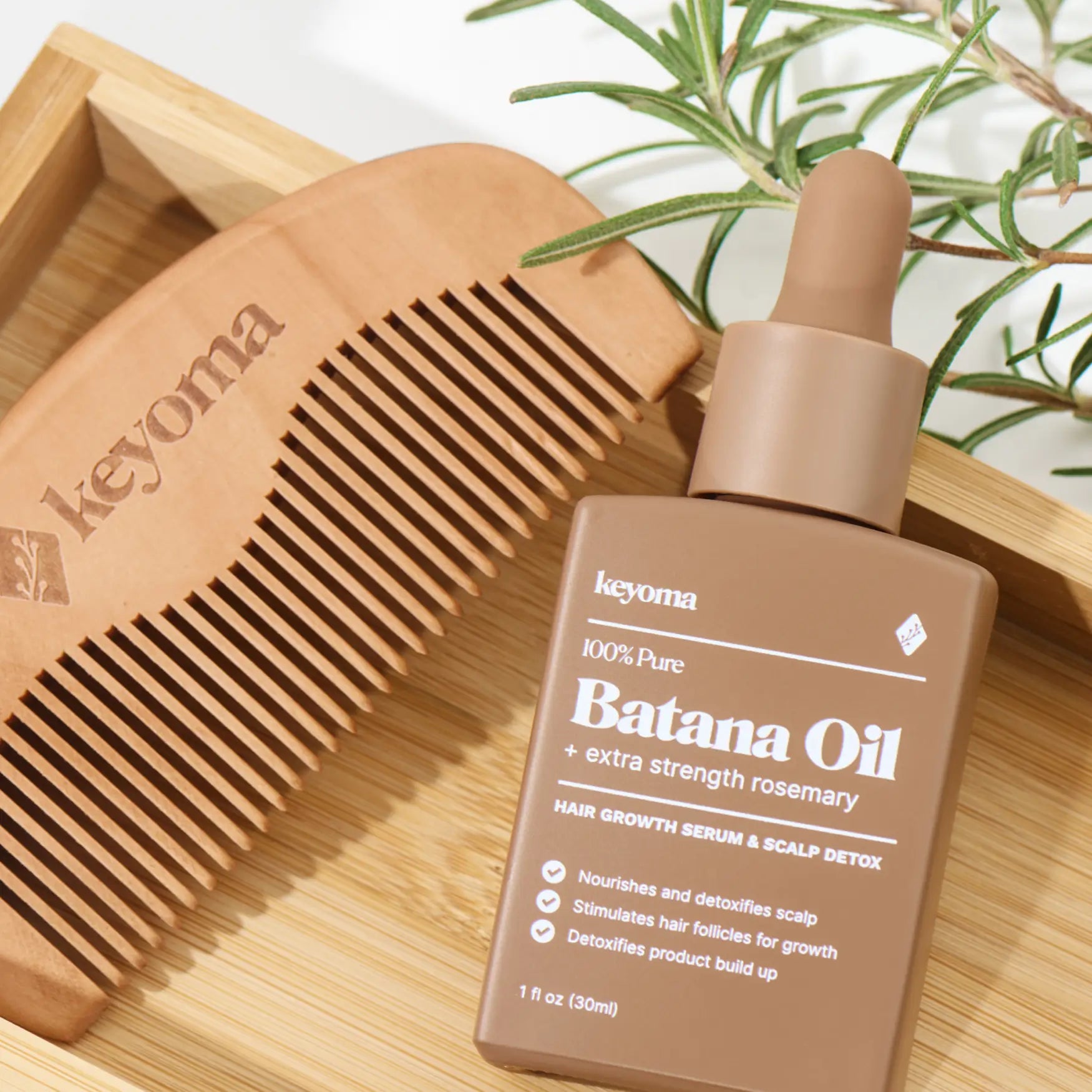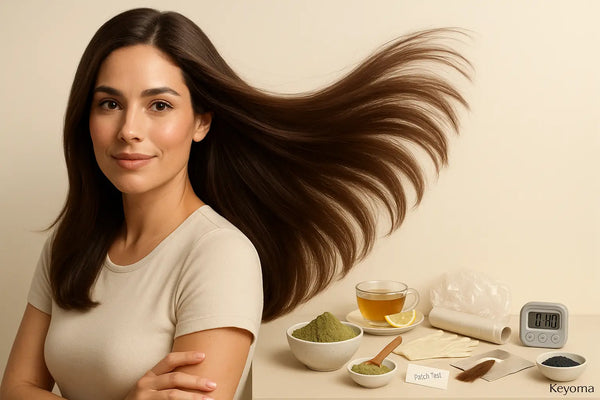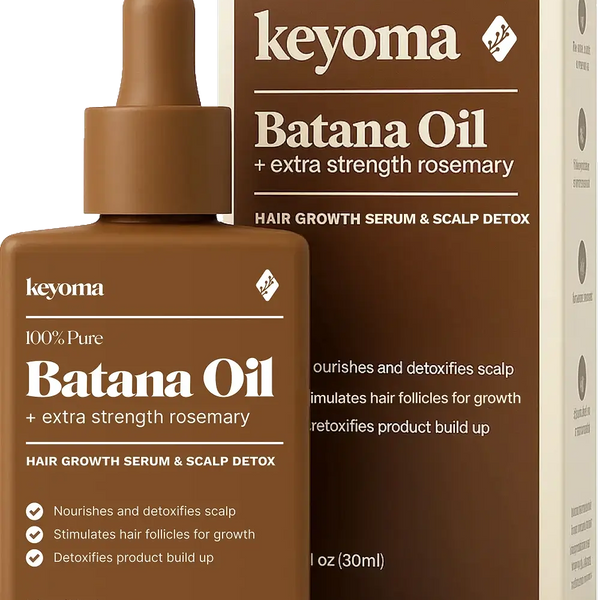Last updated
Aug 27, 2025
Difference Between Dry Oil and Regular Hair Oil: Which One Is Best for Your Hair?
Published on
Aug 27, 2025

In this article
Scroll through blogs and videos online and you’ll see plenty of praise for hair oils, but most of them only compare oil to shampoo, conditioner, or other treatments. Yet something I get asked about a lot, which I find doesn't get talked about enough, is oil versus oil—specifically, dry oil compared with regular hair oil.
And if you’re new to hair oils, this can be surprising. Even borderline overwhelming, because suddenly you’re hit with another problem to sort out: which type should I buy first?
That’s exactly what this guide is for. I'll clear up the confusion, explain what makes dry and regular oils different, and help you decide which one fits your routine best.
Key Takeaways
-
Dry oils absorb fast and feel light, making them ideal for everyday use and quick shine.
-
Regular oils are thicker, absorb slower, and work best for deep conditioning or overnight treatments.
-
Both types nourish the scalp, strengthen strands, and can be used together depending on your hair’s needs.
What Is Dry Oil for Hair?
Dry oil refers to lightweight oils that absorb quickly into the hair and scalp without leaving a greasy film. These oils are often rich in polyunsaturated fatty acids, like linoleic acid, which allows them to spread easily and sink in fast.
Common examples of dry hair oils include:
-
grapeseed oil
-
sunflower oil
-
argan oil
-
jojoba oil
-
rosehip oil
When applied, they glide smoothly, nourish the scalp, and give hair a soft sheen without heaviness. And just to be clear, “dry” doesn’t mean the oil is literally dry (because how can oil be dry), nor does it mean it will dry out your strands. It simply describes the clean, non-sticky finish these oils leave behind.
What Is Regular Hair Oil?
Regular hair oils are the heavier, more traditional oils that sit longer on the hair shaft and scalp before absorbing. They’re typically rich in saturated fatty acids or monounsaturated fats, which makes them thicker and more effective in keeping the scalp moisturized.
Some examples of these traditional hair oils include:
-
batana oil
-
coconut oil
-
castor oil
-
olive oil
-
almond oil
Because of their thicker nature, these oils coat the strand well, sealing in moisture and helping to prevent protein loss. That’s why they’re especially effective when used in deep treatments or as overnight masks.
Differences Between Dry Oil vs Regular Hair Oil
Ingredients & Texture
To set the context properly, let’s start with the similarity first. Both dry oils and traditional oils come from natural plant sources and are packed with fatty acids, vitamins, and antioxidants that help nourish the hair and scalp.
Where they differ is in the dominant fatty acids they contain—and that’s what influences their texture.
Dry oils are usually higher in polyunsaturated fatty acids like linoleic acid. This chemical makeup gives them a lighter, thinner texture. Dry oils such as grapeseed, sunflower, and rosehip spread easily across strands and disappear quickly without residue.
Regular, traditional oils, on the other hand, are richer in saturated fats or monounsaturated fatty acids. This is the case for coconut, castor, and batana oils, and it’s what gives them their thicker, heavier consistency.
So, dry oils are light, while regular oils are thicker. But why does that matter? That leads us to the next point…
Absorption
Absorption, in the simplest sense, is how well your hair and scalp take in the nutrients from an oil. It matters because the more effectively an oil absorbs, the quicker those vitamins, fatty acids, and antioxidants can nourish the scalp and hair shaft.
Dry oils, being lighter, slip into the cuticle quickly, leaving hair soft without weighing it down. Regular oils, being thicker, take more time to penetrate.
And just to be really clear—both actually absorb well, it’s just that one does it quicker and the other slower.
On that note, I get why some people say they don’t like regular oils. As many say, they sit too long on the hair and can leave it looking greasy. That’s fair. But you know what’s not fair? Claiming that, for that reason alone, dry oil is always better than regular hair oil.
From someone who uses both regularly, that’s simply a myth. When regular oils “don’t work,” it usually comes down to two things…
Either they slapped on hair oil without care and blamed the bad experience OR they just didn’t know how to make the most of regular oil’s naturally slow-absorbing qualities. And nine times out of ten, it's the latter!
So now the question is, how do you get the best results out of either type of oil? That leads us to…
Best Use Case
The thicker texture and slow-absorbing nature of traditional hair oils make them perfect for overnight masks, thorough scalp massages, or protective treatments before washing.
That extra time on the hair means they can coat strands fully, sealing in moisture and reducing protein loss. So, if your hair feels brittle or your scalp is chronically dry, this slower absorption actually becomes an advantage rather than a drawback.
Now, how about dry hair oils?
Because of their lightweight texture and quick absorption, dry oils are the kind you can apply in the morning without worrying about greasiness, or as a finishing touch after styling.
On top of that, I bet most hair care enthusiasts would agree that dry oils are a lifesaver when you’re rushing out for an errand and don’t have the time to wait around for a heavier oil to sink in.
All that's to say traditional oils shine in intensive treatments while dry oils are suited for quick, everyday use.
Hair Type Suitability
Different hair types respond differently to dry and regular oils, and knowing this saves you from a lot of unnecessary trial and error.
Fine or thin hair, for example, tends to get greasy quickly. Dry oils like grapeseed or jojoba are a safer pick here since they nourish without flattening strands or adding extra buildup.
On the other hand, thick, coarse, or curly hair, which can sometimes be prone to dryness or frizz, benefits more from traditional oils. Castor or batana, for example, are well-known for locking in the deep moisture these hair types need.
And one last heads-up. Just because you have thick hair doesn’t mean you can’t use dry oils, and the same goes the other way around. These are general guidelines, but at the end of the day, it’s about experimenting and finding what feels best for your scalp and hair.
Build Up Risk
Build-up refers to the residue left behind—oil residue in this case—on the scalp and hair over time. It matters because too much buildup can block follicles, weigh hair down, and even make shampoos less effective.
Dry oils, because they absorb quickly and leave a lighter finish, carry a lower risk of buildup. They’re less likely to sit on the scalp or strand surface.
Regular oils, thanks to their thicker texture, are more prone to causing buildup. This doesn’t make them instantly bad though. It just means you need a more thoughtful approach. To apply them in moderation and follow up with proper cleansing. Apply too much or skip a good wash and that’s when the problems start.
Does the Difference Matter?
We’ve already seen how the main difference between dry and regular oils comes down to texture and absorption. One sinks in faster, the other lingers longer for deeper nourishment. That shapes how you might choose to use them day to day. So in that sense, yes, the difference can matter.
However, when you look at the bigger picture, it’s worth remembering that hair oil is hair oil. No matter the type, both bring the same core benefits because at the end of the day, they’re all nutrient-rich plant oils that:
-
Nourish the scalp with vitamins and antioxidants
-
Strengthen strands by reducing protein loss
-
Soften hair and improve manageability
-
Protect against dryness and outside elements like heat or pollution
-
Serve as carrier oils to mix with essential oils for extra benefits like deeper nourishment or improved absorption
So here’s a thought—and I say this from experience—why not use both?
How To Use Dry Oil and Regular Hair Oil
As we touched on before, you don’t have to pick one over the other. In fact, using them together can give you the best of both worlds.
Here’s how you can work them into a full routine, step by step:

-
Apply regular hair oil first. Massage it into your scalp to condition deeply. Leave it on for at least 30 minutes or overnight for a more intensive treatment. Batana oil, being balanced, is gentle enough for daily use.
-
Rinse and wash with a gentle shampoo to remove excess oil and keep buildup away.
-
Use conditioner as usual to lock in hydration and restore softness after cleansing.
-
Finish with a dry oil (like grapeseed or jojoba) after washing and styling. Smooth a small amount through the mid-lengths and ends to add shine without the heaviness.
It’s also entirely possible to layer them in one routine. Apply a small amount of regular oil at the roots for scalp health, then finish with a mist or light touch of dry oil on the mids and ends for shine and manageability.
Frequently Asked Questions (FAQs)
Is a dry hair oil the same as a serum?
Not exactly. Dry oils are primarily lightweight plant oils (though sometimes blended with silicones) that absorb into the scalp and hair.
A serum, on the other hand, is usually a silicone-based product designed to coat the hair shaft, giving instant smoothness and shine. Some serums also include added ingredients like vitamins, proteins, or even more unique actives such as bee venom.
Can I layer both dry oil and traditional hair oil?
Yes, you can layer dry oil and traditional hair oil. Use a traditional oil first on the scalp for deeper nourishment, then follow with a light touch of dry oil on the mid-lengths and ends for shine without heaviness. Just keep amounts moderate so you don’t overload the hair.
Will using either dry oil or regular oil make my hair fall out?
No. Applying hair oils, dry or regular, doesn’t cause hair loss. What sometimes happens is that when you massage the scalp, weak hairs that were already in the shedding phase may come loose. That’s normal hair turnover, not the oil making you lose hair.
Wrapping Up On Dry Oil vs Regular Hair Oil
To recap, dry oils give you a quick, clean finish that works well for everyday shine, while regular oils deliver deep, long-lasting conditioning when your scalp or strands need extra care.
And speaking as a big hair girl, the smartest move isn’t choosing one over the other. It’s knowing when and how to use both together.
If you’re just starting out with hair oils, a simple blend can be the perfect welcome. And nothing starts you off on a warmer note than a batana + rosemary oil blend, which brings together the deep nourishing qualities of batana with the scalp-stimulating benefits of rosemary.
For even more practical tips, product guides, and step-by-step routines, visit the Keyoma Blog. You’ll find detailed comparisons and expert-backed advice to help you keep your scalp and hair at their healthiest.
Featured Product
100% Pure Batana Oil + Rosemary
Learn more about Batana Oil
Your Cart
Your Cart is empty
Let's fix that
You might like...
Search our store








